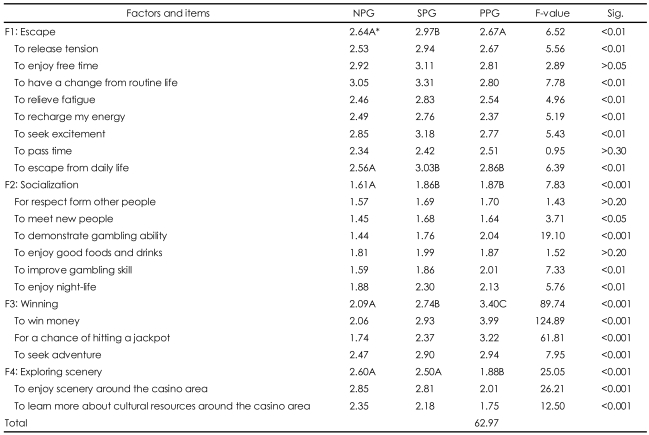1. Derevensky JL, Gupta R. Prevalence estimates of adolescent gambling: a comparison of the SOGS-RA, DSM-IV-J, and the GA 20 questions. J Gambl Stud 2000;16:227-251. PMID:
14634314.


2. Hardoon K, Derevensky JL, Gupta R. Empirical measures vs. perceived gambling severity among youth: why adolescent problem gamblers fail to seek treatment. Addict Behav 2003;28:933-946. PMID:
12788266.


3. Platz L, Millar M. Gambling in the context of other recreation activity: a quantitative comparison of casual and pathological student gamblers. Journal of Leisure Research 2001;33:383-395.

4. Desai RA, Maciejewski PK, Dausey DJ, Caldarone BJ, Potenza MN. Health correlates of recreational gambling in older adults. Am J Psychiatry 2004;161:1672-1679. PMID:
15337659.


5. Neighbors C, Lostutter TW, Cronce JM, Larimer ME. Exploring college student gambling motivation. J Gambl Stud 2002;18:361-370. PMID:
12514915.



6. Chantal Y, Vallerand RJ, Vallieres EF. Motivation and gambling involvement. The Journal of Social Psychology 1995;135:755-763. PMID:
8714442.


7. Tarras J, Singh AJ, Moufakkir O. The profile and motivations of elderly women gamblers. UNLV Gaming Research and Review Journal 2000;5:33-46.
8. Loroz PS. Golden-age gambling: psychological benefits and self-concept dynamics in aging consumers' consumption experiences. Psychology and Marketing 2004;21:323-349.

9. McIntyre N, Pigram JJ. Recreation specialization reexamined: the case of vehicle-based campers. Leisure Sciences 1992;14:3-15.

10. Schuett MA. Refining measures of adventure recreation involvement. Leisure Sciences 1993;15:205-216.

11. Wiley SGE, Shaw SM, Havitz ME. Men's and women's involvement in sports: an examination of the gendered aspects of leisure involvement. Leisure Sciences 2000;22:19-31.

12. Havits ME, Dimanche F, Bogle T. Segmenting the adult fitness market using involvement profiles. Journal of Park and Recreation Administration 1994;12:38-56.
13. McIntyre N. The personal meaning of participation: enduring involvement. Journal of Leisure Research 1989;21:167-179.

14. Selin SW, Howard DR. Ego involvement and leisure behavior: a conceptual specification. Journal of Leisure Research 1988;20:237-244.

15. Scott D, Shafer CS. Recreational specialization: a critical look at the construct. Journal of Leisure Research 2001;33:319-343.

16. Bryan H. Leisure value systems and recreational specialization: the case of trout fishermen. Journal of Leisure Research 1977;9:174-187.

17. Stebbins RA. Amateurs, professionals, and serious leisure. 1992,Montreal, QC: McGill-Queen's University Press.
18. Jang HC, Lee BK, Park MK, Stokowski PA. Measuring underlying meanings of gambling from the perspective of enduring involvement. Journal of Travel Research 2000;38:230-238.

19. Dimanche F, Samdahl D. Leisure as symbolic consumption: a conceptualization and prospectus for future research. Leisure Sciences 1994;16:119-129.

20. Kim SS, Scott D, Crompton JL. An exploration of the relationship among social psychological involvement, behavioral involvement, commitment, and future intentions in the context of birdwatching. Journal of Leisure Research 1997;29:320-341.

21. Havitz ME, Dimanche F. Leisure involvement revisited: conceptual conundrums and measurement advances. Journal of Leisure Research 1997;29:245-278.

22. Cotte J. Chances, trances, and lots of slots: gambling motives and consumption experiences. Journal of Leisure Research 1997;29:380-406.

23. Fisher S. The pull of the fruit machine: a sociological typology of young players. The Sociological Review 1993;41:446-474.

24. Ursua MP, Uribelarrea LL. 20 questions of Gamblers Anonymous: a Psychometric Study with Population of Spain. J Gambl Stud 1998;14:3-15. PMID:
12766432.


26. Hair JF, Anderson RE, Tatham RL, Black WC. Multivariate Data Analysis. 5th ed. New Jersey: Prentice Hall.
27. Lee CK, Lee YK, Bernhard BJ, Yoon YS. Segmenting casino gamblers by motivation: a cluster analysis of Korean gamblers. Tourism Management 2006;27:856-866.

28. Nunnally J, Bernstein I. Psychometric Theory. 1994,3rd ed. New York, NY: McGraw-Hill.
29. Park MK, Yang X, Lee BK, Jang HC, Stokowski PA. Segmenting casino gamblers by involvement profiles: a Colorado example. Tourism Management 2002;23:55-65.

30. Jacobs DF. In: Shaffer HJ, Stein SA, Gambino B, Cummings TNA general theory of addictions. , editor. Compulsive Gambling: Theory, Research and Practice. 1989,Lexington Books, MA.














